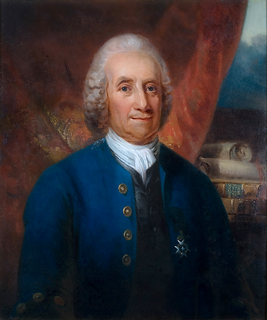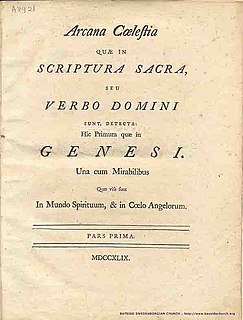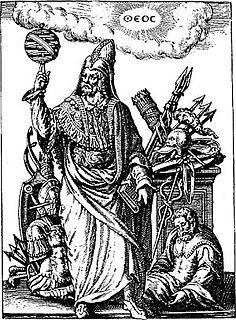 W
WEmanuel Swedenborg was a Swedish pluralistic-Christian theologian, scientist, philosopher and mystic. He is best known for his book on the afterlife, Heaven and Hell (1758).
The New Church is any of several historically related Christian denominations that developed as a new religious group, influenced by the writings of scientist and Swedish Lutheran theologian Emanuel Swedenborg (1688–1772). According to Swedenborg, he received a new revelation from Christ in visions he experienced over a period of at least twenty-five years. He predicted in his writings that God would replace the traditional Christian Church, establishing a New Church that would worship Jesus Christ as God. According to New Church doctrine, each person must cooperate in repentance, reformation, and regeneration.
The New Church is any of several historically related Christian denominations that developed as a new religious group, influenced by the writings of scientist and Swedish Lutheran theologian Emanuel Swedenborg (1688–1772). According to Swedenborg, he received a new revelation from Christ in visions he experienced over a period of at least twenty-five years. He predicted in his writings that God would replace the traditional Christian Church, establishing a New Church that would worship Jesus Christ as God. According to New Church doctrine, each person must cooperate in repentance, reformation, and regeneration.
 W
WAll Religions are One is a series of philosophical aphorisms by William Blake, written in 1788. Following on from his initial experiments with relief etching in the non-textual The Approach of Doom (1787), All Religions are One and There is No Natural Religion represent Blake's first successful attempt to combine image and text via relief etching, and are thus the earliest of his illuminated manuscripts. As such, they serve as a significant milestone in Blake's career; as Peter Ackroyd points out, "his newly invented form now changed the nature of his expression. It had enlarged his range; with relief etching, the words inscribed like those of God upon the tables of law, Blake could acquire a new role."
 W
WThe Arcana Cœlestia, quae in Scriptura Sacra seu Verbo Domini sunt, detecta, usually abbreviated as Arcana Cœlestia or under its Latin variant, Arcana Cælestia, is the first and largest work published by Emanuel Swedenborg in his theological period. It was written and published in Neo-Latin, in eight volumes, one volume per year, from 1749 to 1756.
 W
WFountain Grove was a utopian colony founded near Santa Rosa, California, by Thomas Lake Harris in 1875. Most of its settlers were followers of Harris's Brotherhood of the New Life and moved with Harris from their previous colony at Brocton, New York.
 W
WGlencairn (1928–39) is a castle-like mansion in Bryn Athyn, Pennsylvania, that was home to the Pitcairn family for more than 40 years. Now the Glencairn Museum, it contains a collection of about 8,000 artworks, mostly religious in nature, from cultures such as ancient Egypt, ancient Greece, the Roman Empire and medieval Europe, as well as Islamic, Asian, and Native American works. The museum is affiliated with The New Church, and the building is on the National Register of Historic Places.
 W
WHeaven and Hell is the common English title of a book written by Emanuel Swedenborg in Latin, published in 1758. The full title is Heaven and its Wonders and Hell From Things Heard and Seen, or, in Latin: De Caelo et Eius Mirabilibus et de inferno, ex Auditis et Visis. It gives a detailed description of the afterlife; how people live after the death of the physical body. The book owes its popular appeal to that subject matter.
 W
WLight in My Darkness is a book, originally published in 1927 as My Religion, written by Helen Keller when she was 47 years old. The book was written as a tribute to Emanuel Swedenborg whom Helen regarded as "one of the noblest champions true Christianity has ever known". This book is regarded as Keller's spiritual autobiography in which she openly told that "the teachings of Emanuel Swedenborg have been my light, and a staff in my hand and by his vision splendid I am attended on my way".
 W
WThe Swedenborg Rite or Rite of Swedenborg was a fraternal order modeled on Freemasonry and based upon the teachings of Emanuel Swedenborg. It comprised six Degrees: Apprentice, Fellow Craft, Master Neophyte, Illuminated Theosophite, Blue Brother, and Red Brother.
 W
WThere is No Natural Religion is a series of philosophical aphorisms by William Blake, written in 1788. Following on from his initial experiments with relief etching in the non-textual The Approach of Doom (1787), All Religions are One and There is No Natural Religion represent Blake's first successful attempt to combine image and text via relief etching, and are thus the earliest of his illuminated manuscripts. As such, they serve as a significant milestone in Blake's career; as Peter Ackroyd points out, "his newly invented form now changed the nature of his expression. It had enlarged his range; with relief etching, the words inscribed like those of God upon the tables of law, Blake could acquire a new role."